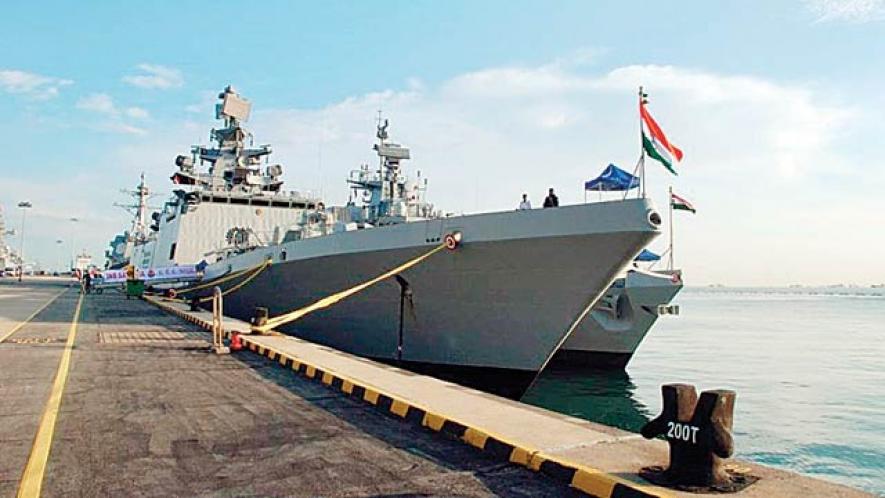The Seafarers Tale – Bloodied and Wounded By Shipping Line Sharks

Image Courtesy: DNA India
One of the less visible sectors of India’s economy is its merchant navy – the ships that carry cargo to and from Indian ports to all corners of the world. Many would be astonished to learn that about 95% of foreign trade by volume (and 68% by value) is through this merchant navy that currently has about 1376 ships. Although a large majority of these ships (about 69%) ply on Indian coastal routes but the remaining 31% that go to foreign shores carry almost 86% of the cargo. There is a ‘navratna’ status public sector company – Shipping Corporation of India – that itself operates 67 cargo ships, there is a whole ministry of shipping with a budget of Rs.1818 crore, and there is India’s 1750 km long coastline dotted with ports.
An even less visible part of this key strategic industry is about 150,000 workers who run the ships. They are variously known as seamen or seafarers or ratings. It’s a tough job – the seafarers have to be away from home, aboard the ship for up to 9 months if their ship is on a long foreign route. One back home, they get ‘leave’ at a basic allowance and then they have to seek reassignment to duty. Wages are low, work hours long and arduous, work full of hazards, job security fragile and almost no safety net after retirement. And, things are getting worse.
One of the biggest issues facing seafarers is that of wages, according to seafarers NewsClick spoke to. Govt. of India agreed to the International Labour Organisation’s Maritime Labour Convention and declared as much in a notification published in the Gazette Extraordinary on 29 February 2016. Section 9 (5) of the notification expressly states that “The wages included in the collective bargaining agreement or the Seafarers’ Employment Agreement shall be in accordance with the guidelines as laid down in the Maritime Labour Convention.” In a memorandum submitted to the Prime Minister by the Forward Seaman’s Union of India, on 21 November 2016, the seafarers urged that since the ILO’s Convention recommends a monthly basic wage of $614 (about Rs.41,500)govt. should ensure that they get it.
At present, seafarers get as little as Rs.7000 basic pay with additional allowances and ex gratia amounts that may vary. Keep in mind: once the seafarers gets back on home shore, he goes on ‘leave’ and may not be re-employed till the ship line agrees to do so.
Earlier, there used to be a Seamen Employment Office which had a roster system giving duties to seafarers by rotation. This was scrapped in 1994 and replaced by ship owners’ right to employ or not employ any seafarer.
The 1990s also saw other changes flowing from a deliberate withdrawal of govt.’s responsibility and increase of private companies’ clout in the shipping industry. The govt. run seafarers’ training institutes were closed down and 144 private institutes have since mushroomed producing 10-15 thousand fresh seafarers every six months. About 529 Recruitment and Placement Services Agencies have sprouted up offering to get the flood of new seafarers jobs in the private shipping industry.
But the govt. – at the instance of private shipping companies – also brought down the manning levels (number of seafarers per ship at sea) from 60-70 to just 8-12 per ship. Ironically, this was called ‘Safe Manning” standard. Not only did this change increase workload on each seafarer on a ship, it drastically reduced the demand for new recruits – at a time when thousands of new trained seafarers were flooding the streets!
This has helped the shipping lines to keep wages in check, increase workload and ensure that the workforce remains pliable and cowed down. Seafarers NewsClick spoke to gave instances of companies getting rid of those who protested.
Another major reason why the seafarers’ are restive and angry is the lack of any pension facility. Each retired (and registered) seafarer gets perhaps the lowest monthly pension in India’s whole organized sector – a paltry Rs.200! Seafarers allege that Rs.5000 crore is lying in various welfare funds but not being used for looking after the retired seafarers who are on the brink of destitution. Although provident fund facility is available to seafarers (albeit based on a very low basic wage), and they are covered by personal insurance while at sea, there is no provision for family’s medical insurance or coverage.
Thus in many ways, seafarers are on the lowest rung of the workers and employees in the organized sector – in fact it would be more apt to call them informal/unorganized sector workers now. All this has happened since the 1990s with the advent of liberalization.
The hapless seafarers have been fighting – they write letters, send memoranda, hold small protest actions at the Ship Master’s office or the ship line’s headquarters, in 2012 they even had stopped work on ships in a wildcat action. Recently, their union has approached both the Supreme Court and the Bombay High Court for relief.
But the private industry is powerful, and the govt. is weak. So the battle goes on.
Get the latest reports & analysis with people's perspective on Protests, movements & deep analytical videos, discussions of the current affairs in your Telegram app. Subscribe to NewsClick's Telegram channel & get Real-Time updates on stories, as they get published on our website.
























